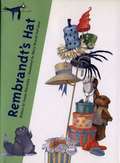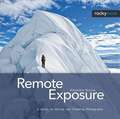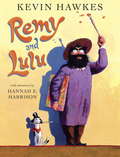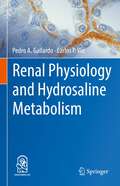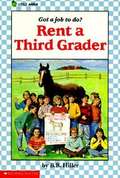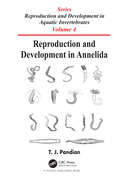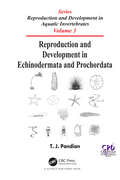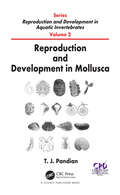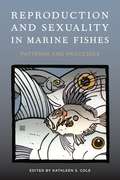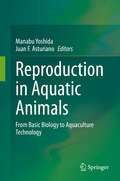- Table View
- List View
Rembrandt's Hat
by Susan BlackabyOn what began as a fine day, a bear named Rembrandt lost his hat. As all of us do now and then, Rembrandt meets up with an unlucky day. He loses something special, something that belonged to him, something hard to replace. It is a frustrating predicament, especially as a bossy bird, a bored cat, and an outspoken rabbit decide to help. Too polite and accommodating to refuse, Rembrandt must find-little by little-a way to take care of things on his own. With unique mixed-media illustrations, Mary Newell DePalma brings to life this world populated by quirky animals and stylish hats, and together art and text reveal the merits and rewards of patience and perseverance.
Remind Me
by Linda ShuteThis poignant story about a young elephant and his grandma is an eloquent account of the all too familiar tragedy of memory loss, and the love of family that never leaves.Eldon the elephant's beloved Big Ella has always had a knack for memory, so when she starts to forget little things, Eldon happily returns the favor. But when she starts to forget where she lives, Eldon's name, and even her own name, he starts to worry. Yet Eldon always remembers the love he shares with Big Ella, and he makes sure to remind her whenever she needs him to.It can be especially hard for children to process the grief of watching their grandparents forget themselves when suffering from Alzheimer&’s or dementia. Linda Shute&’s Remind Me approaches the issue with humanity and compassion, celebrating the lasting love that brings families together. Her art has a soft, gentle tone and depicts an idyllic jungle setting inhabited by a charming elephant duo.
Remnants of Ancient Life: The New Science of Old Fossils
by Dale E. GreenwaltThe revolution in science that is transforming our understanding of extinct lifeWe used to think of fossils as being composed of nothing but rock and minerals, all molecular traces of life having vanished long ago. We were wrong. Remnants of Ancient Life reveals how the new science of ancient biomolecules—pigments, proteins, and DNA that once functioned in living organisms tens of millions of years ago—is opening a new window onto the evolution of life on Earth.Paleobiologists are now uncovering these ancient remnants in the fossil record with increasing frequency, shedding vital new light on long-extinct creatures and the lost world they inhabited. Dale Greenwalt is your guide to these astonishing breakthroughs. He explains how ancient biomolecules hold the secrets to how mammoths dealt with the bitter cold, what colors dinosaurs exhibited in mating displays, how ancient viruses evolved to become more dangerous, and much more. Each chapter discusses different types of biomolecules and the insights they provide about the physiology, behavior, and evolution of extinct organisms, many of which existed long before the age of dinosaurs.A marvelous adventure of discovery, Remnants of Ancient Life offers an unparalleled look at an emerging science that is transforming our picture of the remote past. You will never think of fossils in the same way again.
Remote Exposure: A Guide to Hiking and Climbing Photography
by Alexandre BuisseThough many hikers and climbers carry cameras with them, they often come away feeling disappointed because their images fail to visually translate their experiences. In Remote Exposure Alexandre Buisse goes beyond the mere basics of photography and gives you the tools needed to create images that are not only of good technical quality but that are compelling as well. This book will guide you through the various options for equipment, since the requirement for lightweight gear that is able to withstand cold, adverse weather conditions presents unique challenges. Learn about the importance of having an efficient carrying system and a logical, planned workflow. Throughout the book you will find advice on where to point your camera and how to compose a strong image. Included are specific requirements for rock climbing, hiking, mountaineering, and camping. More advanced photographic topics are also covered such as digital capture and optimization techniques like high dynamic range imaging (HDRI), panoramic stitching, and how to achieve excellent results without a tripod. The pages are filled with over 100 stunning images captured by Buisse as he hiked and climbed through mountain ranges on three continents. Photographers of all levels and those who just appreciate beautiful images are sure to be inspired by this book. Foreword by Cory Richards (member of the historic climbing expedition that reached the summit of Gasherbrum II in winter).
Remy Sneakers and the Lost Treasure (Remy Sneakers #2)
by Kevin SherryA hilariously illustrated early chapter book about a racoon who calls on his friends to help him find out who stole his family’s memoirs.Someone has ransacked Remy’s home and stolen his prized possession, a book of Raccoon Family stories. But anyone could have done the dirty deed. Was it a sneaky pack of alley cats out to make a quick buck? Or maybe Big Al, the notorious king of the sewers? Or could it be the work of a mysterious masked figure? It’s up to Remy and the rest of the Critter Crew to go undercover, track down the thief, and recover the book . . . or Remy’s missing memories will be lost forever!
Remy Sneakers vs. the Robo-Rats (Remy Sneakers #1)
by Kevin SherryThis illustrated early chapter book about a wily raccoon and his animal friends chasing down an evil robot-making scientist is a “madcap series opener” (Kirkus Reviews).Remy Sneakers has never needed anyone’s help. He’s an independent raccoon with a crafty mind, a sweet pad, and collections of the coolest stuff imaginable. But when a master thief starts stealing things all over town, Remy is accused of the crimes! Remy will have to find some friends in Mouse Town, Rat City, and Pigeon Place to help him clear his name. And when it turns out an evil toymaker with an army of robots is behind the thefts—and ready to take control of the whole city—Remy and his new crew are the only ones who can save their beloved home from total destruction!
Remy and Lulu
by Kevin Hawkes Hannah HarrisonOoh la la! From New York Times bestseller Kevin Hawkes, illustrator of Library Lion and Weslandia, comes the charming story of a dog and her owner who become the toast of Paris. Lulu and her master, Remy, a passionate but struggling portrait painter, wander the French countryside looking for customers. They don't need much business --just enough for some figs and cheese to keep their bellies full--but not many people seem to appreciate Remy's abstract style. Before long, Lulu secretly lends a paw to Remy's work and--voilà!--the pair are the most celebrated artists on the salon circuit. If only Remy knew why . . . With art from both beloved children's book illustrator Kevin Hawkes and award-winning miniatures artist Hannah Harrison, this funny and heartwarming story about friendship and creativity shows that there are many ways to be good at the same thing . . . and that a true friend is always there for you.
Remy and Lulu: Read & Listen Edition
by Kevin HawkesOoh la la! From New York Times bestseller Kevin Hawkes, illustrator of Library Lion and Weslandia, comes the charming story of a dog and her owner who become the toast of Paris. Lulu and her master, Remy, a passionate but struggling portrait painter, wander the French countryside looking for customers. They don&’t need much business —just enough for some figs and cheese to keep their bellies full—but not many people seem to appreciate Remy&’s abstract style. Before long, Lulu secretly lends a paw to Remy&’s work and—voilà!—the pair are the most celebrated artists on the salon circuit. If only Remy knew why . . . With art from both beloved children&’s book illustrator Kevin Hawkes and award-winning miniatures artist Hannah Harrison, this funny and heartwarming story about friendship and creativity shows that there are many ways to be good at the same thing . . . and that a true friend is always there for you.This Read & Listen edition contains audio narration.
Renaissance Dogs: Curious canines from a bygone age (Medieval Cats)
by Professor Taylor WagmoreIf every dog has its day, then the Renaissance period was it. It was the time when Leonardo, Raphael, Michelangelo, Donatello (not the Teenage Mutant Ninja Turtles, FYI) ruled the art world and Shakespeare invented the English language. It was also the time when Christopher Columbus 'discovered' the Americas and Johannes Gutenberg printed the first ever book. It was the time, well, you get the picture. It was also the time of dogs. They were everywhere. But especially in pictures and paintings. And always by our side. Highly valued as status symbols, loyal companions, protectors and hunters.Stuffed with more than 100 high-resolution dog-based artworks, produced between 1400-1650, and sourced from museums and art collections all around the world, Renaissance Dogs is the very first dog-alogue of its kind. It's a comical celebration of man's best friend, as seen through their eyes, and offers readers valuable insight into the world of dogs during the Golden Age and how they were represented in timeless art masterpieces.
Renaissance Porticoes and Painted Pergolas: Nature and Culture in Early Modern Italy (Visual Culture in Early Modernity)
by Natsumi NonakaThis book is the first study of the portico and its decorative program as a cultural phenomenon in Renaissance Italy. Focusing on a largely neglected group of porticoes decorated with painted pergolas that appeared in Rome and environs in the sixteenth and early seventeenth centuries, it tells the story of how an element of the garden—the pergola—became a pictorial topos in portico decoration, and evolved, hand in hand with its real cousin in the garden, into an object for cultural emulation among the educated patrons of early modern Rome. The liminality of both the portico and the pergola at the interface of architecture and garden is key to the interpretation of these architectural and painted forms, which rests on the intersecting frameworks of the classical tradition, natural history, and the cultural identity of the aristocracy. In the mediating space of the Renaissance portico, the illusionism pergola created an art gallery, a natural history museum, and a virtual garden where one could engage in leisurely strolls, learned conversations, appreciation of art, and scientific investigation, as well as extensive travel across time and space. The book proposes the interpretation that the illusionistic pergola was an artistic formula for the early modern perception of nature.
Renaissance Posthumanism
by Joseph Campana and Scott MaisanoConnecting Renaissance humanism to the variety of “critical posthumanisms” in twenty-first-century literary and cultural theory, Renaissance Posthumanism reconsiders traditional languages of humanism and the human, not by nostalgically enshrining or triumphantly superseding humanisms past but rather by revisiting and interrogating them. What if today’s “critical posthumanisms,” even as they distance themselves from the iconic representations of the Renaissance, are in fact moving ever closer to ideas in works from the fourteenth to the seventeenth century? What if “the human” is at once embedded and embodied in, evolving with, and de-centered amid a weird tangle of animals, environments, and vital materiality? Seeking those patterns of thought and practice, contributors to this collection focus on moments wherein Renaissance humanism looks retrospectively like an uncanny “contemporary”—and ally—of twenty-first-century critical posthumanism.
Renal Physiology and Hydrosaline Metabolism
by Pedro A. Gallardo Carlos P. VioThis volume discusses renal function and the mechanisms by which the kidney regulates the composition and volume of the extracellular fluid. It also highlights the role of the kidney in the development and progression of arterial hypertension. Most textbooks of renal physiology are based in mammalians physiology and mostly human physiology of the kidney, but the authors considered that this book should also include other species to include the broad spectrum of students and researchers in the life and biomedical sciences. In this sense, we included chapters such as comparative osmoregulation in non-mammalian vertebrates and we emphasize that in vertebrates like fish, reptiles, amphibians and birds, the kidneys and extrarenal organs are vital to maintain fluid homeostasis. The purpose of the book is to provide a concise frame of knowledge in a clear and direct language, of the renal function to medical and biological sciences students. In the context of normal renal function, we provide pathophysiological basis for chronic renal diseases and hypertension with the participation of renal vasoactive hormones. This book is used as textbook in several physiology courses for medical, nursing and biological sciences students at the Pontifical Catholic University of Chile, Finis Terrae University, Universidad San Sebastian as well as other universities.
Renegade Champion: The Unlikely Rise of Fitzrada
by Richard R. Rust&“If you buy that horse, you&’re buying your daughter&’s death warrant,&” Jane Pohl&’s father was warned at the army barracks in the spring of 1941. But the potential that his teenage daughter Jane saw in the small, temperamental Thoroughbred was enough to convince him otherwise.Earlier that year, when Fitzrada arrived at the army base where Jane&’s family lived, the horse was stubborn, unpredictable, and dangerous. Any man who dared addle him up soon found himself face down in the dirt. Jane, excited to ride any horse and up for the challenge, had the most success with Fitz. She was patient and consistent, and the horse responded well at last, showing a great affinity for jumping. Then, inexplicably, a terrible riding accident resulted in serious injuries for both Jane and Fitz, and the army decide that it was time to destroy the horse. Heartbroken, Jane pleaded with her reluctant father: the only way to save Fitz was to buy him from the army.Jane Pohl&’s foresight proved to be correct. Jane and Fitz went on to take the Virginia show-jumping circuit by storm, winning 37 jumper and 6 hinter championships. At a time when women were rarely seen in jumping classes at horse shows and were not taken seriously by male competitors, Jane and Fitz helped to break down barriers against women riders competing in the Olympics. In 1946, Jane and Fitz found themselves at the Jumper Championship at the prestigious National Horse Show in Madison Square Garden—the highest jumping title in North America. The road there for horse and rider was a five-year test of faith, patience, and understanding friendship.
Renegade Reunion (Wyoming Warriors)
by Addison FoxTheir differences once tore them apartNow they&’re the only things keeping them alive Former CIA operative Trace Withrow traded a high-risk career in DC for a ranch in Wyoming, leaving behind the partner he couldn&’t forget. But when Nicola Miles discovers an inside hit on a missing teen, she turns to Trace, stirring up emotions he&’d buried for years. Nicola never liked his &“toss the rule book&” attitude. In fact, their differences ultimately ended their affair. Yet that very character trait could be the lifeline Nicola needs—especially since she doesn&’t know who she can trust at her own agency. Or if she&’s the ultimate target…or Trace…From Harlequin Romantic Suspense: Danger. Passion. Drama.Feel the excitement in these uplifting romances, part of the Wyoming Warriors series:Book 1: Renegade Reunion
Renewable Energy and Wildlife Conservation (Wildlife Management and Conservation)
by Christopher E. Moorman Steven M. Grodsky Susan RuppBrings together disparate conversations about wildlife conservation and renewable energy, suggesting ways these two critical fields can work hand in hand.Renewable energy is often termed simply "green energy," but its effects on wildlife and other forms of biodiversity can be quite complex. While capturing renewable resources like wind, solar, and energy from biomass can require more land than fossil fuel production, potentially displacing wildlife habitat, renewable energy infrastructure can also create habitat and promote species health when thoughtfully implemented.The authors of Renewable Energy and Wildlife Conservation argue that in order to achieve a balanced plan for addressing these two crucially important sustainability issues, our actions at the nexus of these fields must be directed by current scientific information related to the ecological effects of renewable energy production. Synthesizing an extensive, rapidly growing base of research and insights from practitioners into a single, comprehensive resource, contributors to this volume• describe processes to generate renewable energy, focusing on the Big Four renewables—wind, bioenergy, solar energy, and hydroelectric power• review the documented effects of renewable energy production on wildlife and wildlife habitats• consider current and future policy directives, suggesting ways industrial-scale renewables production can be developed to minimize harm to wildlife populations• explain recent advances in renewable power technologies• identify urgent research needs at the intersection of renewables and wildlife conservationRelevant to policy makers and industry professionals—many of whom believe renewables are the best path forward as the world seeks to meet its expanding energy needs—and wildlife conservationists—many of whom are alarmed at the rate of renewables-related habitat conversion—this detailed book culminates with a chapter underscoring emerging opportunities in renewable energy ecology.Contributors: Edward B. Arnett, Brian B. Boroski, Regan Dohm, David Drake, Sarah R. Fritts, Rachel Greene, Steven M. Grodsky, Amanda M. Hale, Cris D. Hein, Rebecca R. Hernandez, Jessica A. Homyack, Henriette I. Jager, Nicole M. Korfanta, James A. Martin, Christopher E. Moorman, Clint Otto, Christine A. Ribic, Susan P. Rupp, Jake Verschuyl, Lindsay M. Wickman, T. Bently Wigley, Victoria H. Zero
Renni the Rescuer
by Felix Salten Kenneth C. KaufmanFrom the author of Bambi, this story of a boy, his dog, and their bravery reaches a new generation of readers with a fresh look.George has always wanted a dog, so when he picks up small Renni, the runt of a litter of German Shepherd puppies, he immediately falls in love. As Renni grows, George begins to teach him, and soon Renni is able to do remarkable things. When a trainer suggests Renni become a rescue dog, George knows it's a perfect fit for his pet. Soon Renni is able to find anyone in any situation. Then the war that has been looming finally begins, and Renni and George enlist. They are able to help many soldiers during training camp--but when they are tested in the actual battlefield, can the two friends hold their ground? Or are they unprepared for the trials ahead?
Rent a Third Grader
by B. B. HillerEveryone in Miss Bilgore's third grade class loves Partner, a retired police horse. But it looks like Partner is headed for a terrible fate--pet food! Then the kids get an idea: each third grader will find odd jobs and earn money to pay for Partner's care.
Reporting for Duty: True Stories of Wounded Veterans and Their Service Dogs
by Tracy J. LibbyInspirational accounts of veterans who have moved forward from mental and physical injuries toward healthier lives with the help of service dogs. Hundreds of thousands of military veterans seek treatment for post-traumatic stress disorder (PTSD) each year. Service dogs have been used for many years in the civilian sector to help their disabled owners perform necessary tasks in daily life; likewise, the organized use of therapy dogs to bring comfort and companionship to hospital and nursing-home patients dates back more than four decades. Reporting for Duty explores the unique and special bond between wounded warriors—especially those suffering from PTSD—and their service dogs and discusses the vital work of therapy dogs who visit VA hospitals and military rehabilitation facilities. Author Tracy Libby tells the true stories of disabled veterans who have been touched, assisted, and enriched by the dogs in their lives, and the new lease on life is reciprocal: many of these service and therapy dogs have been rescued from shelters and specially trained for their jobs. A portion of proceeds from the sale of this book will benefit a veterans&’ service-dog organization.Inside Reporting for Duty . . .True stories of physically and mentally disabled veterans who count on service dogs for assistance with daily tasksAn explanation of PTSD and how it affects military veteransHow therapy dogs and service dogs are selected and trained for their jobsRescuing shelter dogs to train for therapy and service workHow the military is training dogs to accompany soldiers on deploymentsA look at the bond between people and dogs and the positive effects it has on both
Reproduction and Development in Annelida (Reproduction and Development in Aquatic Invertebrates)
by T. J. PandianThis book is a concise informative elucidation of all aspects of reproduction and development in annelids covering from arenicola to tubifex. Annelids flourish between 4,900 m depth to 2,000 m altitude; some of them occur in unusual habitats like hydrothermal vents and subterranean aquatic system (stigobionts). A few have no gut and acquire adequate nutrients through osmotrophism and/or engaging symbiotic microbes. In the absence of exoskeleton to escape predation, the 17,000 speciose annelids have explored bewildering modes of reproduction; not surprisingly, 42–47% of them are brooders. With 13,000 species, polychaetes are gonochores but some 207 species of them are hermaphrodites. Clitellates are all hermaphrodites; of them, 76 species are parthenogens, of which 56 are earthworms. Regenerative potency of annelids ranges from an organ to an entire worm from a single ‘seminal’ segment. The head, tail and both together can be regenerated 21, 42 and 20 times, respectively. However, the potency is limited to ~1% of polychaetes and Heterogamatic sex determination is reported to occur only in six polychaete species, although karyotype is known for 83 annelid species. In temperate polychaetes, a dozen neuroendocrines, arising mostly from the ‘brain’ regulates reproductive cycle. A complete chapter devoted to vermiculture, (i) recognizes the fast-growing candidate species, (ii) distinguishes 'layers' from 'brooders', (iii) indicates that the harvest of oligochaetes may reduce the input of nitrogenous fertilizer in the ricefield, and (iv) explores the scope for increasing wealth from waste.
Reproduction and Development in Echinodermata and Prochordata (Reproduction and Development in Aquatic Invertebrates)
by T. J. PandianEchinoderms and prochordates occupy a key position in vertebrate evolution. The genomes of sea urchin share 70% homology with humans. Researches on cell cycle in sea urchin and phagocytosis in asteroids have fetched Nobel Prizes. In this context, this book assumes immense importance. Echinoderms are unique, as their symmetry is bilateral in larvae but pentamerous radial in adults. The latter has eliminated the development of an anterior head and bilateral appendages. Further, the obligate need to face the substratum for locomotion and acquisition of food has eliminated their planktonic and nektonic existence. Egg size, a decisive factor in recruitment, increases with decreasing depths up to 2,000-5,000 m in lecithotrophic asteroids and ophiuroids but remains constant in their planktotrophics. Smaller ( 110 mm) asteroids generate planktotrophic eggs only. Publications on sex ratio of echinoderms indicate the genetic determination of sex at fertilization but those on hybridization, karyotype and ploidy induction do not provide evidence for heterogametism. But the herbivorous echinoids and larvacea with their gonads harboring both germ cells and Nutritive Phagocytes (NPs) have economized the transportation and hormonal costs on gonadal function. Despite the amazing potential just 2 and 3% of echinoderms undergo clonal reproduction and regeneration, respectively. Fission is triggered, when adequate reserve nutrients are accumulated. It is the most prevalent mode of clonal reproduction in holothuroids, asteroids and ophiuroids. However, budding is a more prevalent mode of clonal reproduction in colonial hemichordates and urochordates. In echinoderms, fission and budding eliminate each other. Similarly, autoregulation of early development eliminates clonal reproduction in echinoids and solitary urochordates. In pterobranchs, thaliaceans and ascidians, the repeated and rapid budding leads to colonial formation. Coloniality imposes reductions in species number and body size, generation time and life span, gonad number and fecundity as well as switching from gonochorism to simultaneous hermaphorditism and oviparity to ovoviviparity/viviparity.
Reproduction and Development in Minor Phyla (Reproduction and Development in Aquatic Invertebrates)
by T. J. PandianThe 26 recognized minor phyla comprise aberrant clades, as most of them terminate as blind offshoots. Untied from the discussion on their phylogenesis of minor phyla, this book is largely devoted, for the first time, to aspects of reproduction and development in minor phyletics. The minor phyla are not as speciose (1,795 species/phylum) as the major phyla (157,066 species/phylum) are. The accumulation of deleterious genes causes inbreeding depression among progenies arising from parthenogenesis, clonal multiplication and selfing hermaphrodites. The reason for the limited species diversity in minor phyla is traced to (i) eutelism in 65.7% of minor phyletics and (ii) existence of 21.6% clonals, (iii) 6.4% parthenogens and (iv) 1.2% selfing hermaphroditism. Gonochorism obligately requires motility to search for a mate. The combination of low motility and gonochorism from Placozoa to hemocoelomatic minor phyla has limited diversity to
Reproduction and Development in Mollusca (Reproduction and Development in Aquatic Invertebrates #2)
by T. J. PandianThis book is perhaps the first attempt to comprehensively project the uniqueness of molluscs, covering almost all aspects of reproduction and development from aplacophorans to vampyromorphic cephalopods. Molluscs are unique for the presence of protective external shell, defensive inking, geographic distribution from the depth of 9,050 m to an altitude of 4,300 m, gamete diversity, the use of nurse eggs and embryos to accelerate the first few mitotic divisions in embryos, the natural occurrence of androgenics in a couple of bivalves, viable induced tetraploids, gigantism induced by elevated ploidy, the complementary role played by mitochondrial genome in sex determination by nuclear genes and the uptake and accumulation of steroid hormone from surrounding waters. In molluscs, sexuality comprises of gonochorism ( 24%), protandry (
Reproduction and Sexuality in Marine Fishes
by Kathleen S. ColeMarine fishes represent astonishing diversity with respect to practically every aspect of their biology. Reproductive modes and sexual patterns are especially fascinating and provide deep insight into general evolutionary problems. In this volume, chapters focus on reproduction and sexuality among groups of fishes defined by habitat, taxon, and the reproductive processes that are critical for reproductive success. The book illustrates how knowledge of reproductive biology among marine fishes can help identify vulnerable and potentially vulnerable species in the face of changing environmental conditions and increasing human-based pressures.
Reproduction in Aquatic Animals: From Basic Biology to Aquaculture Technology
by Manabu Yoshida Juan F. AsturianoThis book provides an up-to-date overview of the various reproductive systems of a variety of aquatic animals, from invertebrates to fishes. While all terrestrial animals use internal fertilization, aquatic animals have diverse reproductive systems. Some are internal fertilizers with or without mating, but many perform external fertilization. Because of this diversity, the reproductive systems of aquatic animals represent excellent models for the study of adaptive evolution and the species specificity of fertilization. In addition, many aquatic animals, including fish, crustaceans, and mollusks, are important as fishery and aquaculture resources. In this book, up-and-coming researchers examine reproductive systems in representative aquatic animals, covering both the basic knowledge and late-breaking results. Reproduction in Aquatic Animals: From Basic Biology to Aquaculture Technology will be of interest to graduate and postgraduate students in biology and agricultural sciences, as well as to researchers and technicians in the fields of reproductive biology and fishery science and to non-academics.
Reproduction in Farm Animals
by B. Hafez E.S.E. HafezWhen you’re looking for a comprehensive and reliable text on large animal reproduction, look no further! the seventh edition of this classic text is geared for the undergraduate student in Agricultural Sciences and Veterinary Medicine. In response to reader feedback, Dr. Hafez has streamlined and edited the entire text to remove all repetitious and nonessential material. That means you'll learn more in fewer pages. Plus the seventh editing is filled with features that help you grasp the concepts of reproduction in farm animals so you'll perform better on exams and in practice: condensed and simplified tables, so they're easier to consult an easy-to-scan glossary at the end of the book an expanded appendix, which includes graphic illustrations of assisted reproduction technology Plus, you'll find valuable NEW COVERAGE on all these topics: Equine Reproduction: expanded information reflecting today's knowledge Llamas (NEW CHAPTER) Micromanipulation of Gametes and In Vitro Fertilization (NEW CHAPTER!) Reach for the text that's revised with the undergraduate in mind: the seventh edition of Hafez's Reproduction in Farm Animals.
